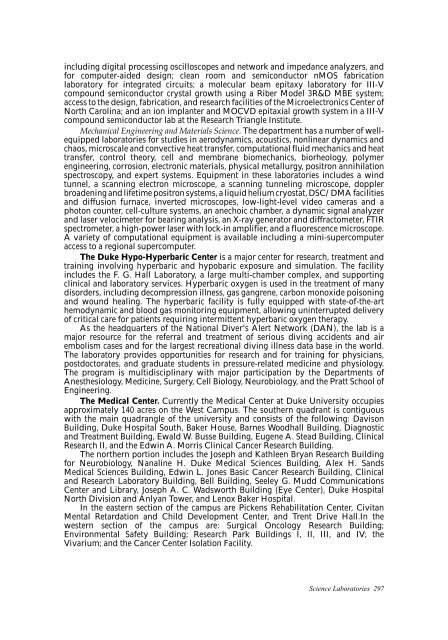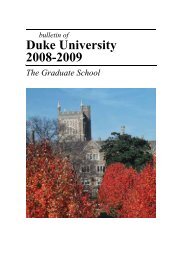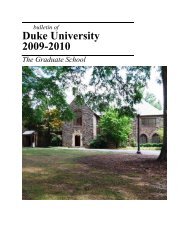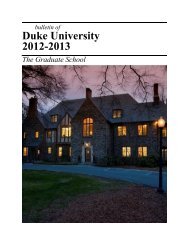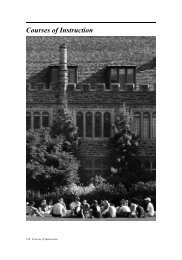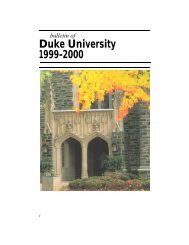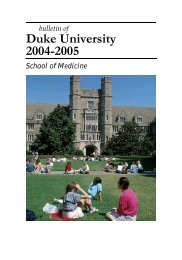Duke University 2003-2004 - Office of the Registrar - Duke University
Duke University 2003-2004 - Office of the Registrar - Duke University
Duke University 2003-2004 - Office of the Registrar - Duke University
Create successful ePaper yourself
Turn your PDF publications into a flip-book with our unique Google optimized e-Paper software.
including digital processing oscilloscopes and network and impedance analyzers, and<br />
for computer-aided design; clean room and semiconductor nMOS fabrication<br />
laboratory for integrated circuits; a molecular beam epitaxy laboratory for III-V<br />
compound semiconductor crystal growth using a Riber Model 3R&D MBE system;<br />
access to <strong>the</strong> design, fabrication, and research facilities <strong>of</strong> <strong>the</strong> Microelectronics Center <strong>of</strong><br />
North Carolina; and an ion implanter and MOCVD epitaxial growth system in a III-V<br />
compound semiconductor lab at <strong>the</strong> Research Triangle Institute.<br />
Mechanical Engineering and Materials Science. The department has a number <strong>of</strong> wellequipped<br />
laboratories for studies in aerodynamics, acoustics, nonlinear dynamics and<br />
chaos, microscale and convective heat transfer, computational fluid mechanics and heat<br />
transfer, control <strong>the</strong>ory, cell and membrane biomechanics, biorheology, polymer<br />
engineering, corrosion, electronic materials, physical metallurgy, positron annihilation<br />
spectroscopy, and expert systems. Equipment in <strong>the</strong>se laboratories includes a wind<br />
tunnel, a scanning electron microscope, a scanning tunneling microscope, doppler<br />
broadening and lifetime positron systems, a liquid helium cryostat, DSC/DMA facilities<br />
and diffusion furnace, inverted microscopes, low-light-level video cameras and a<br />
photon counter, cell-culture systems, an anechoic chamber, a dynamic signal analyzer<br />
and laser velocimeter for bearing analysis, an X-ray generator and diffractometer, FTIR<br />
spectrometer, a high-power laser with lock-in amplifier, and a fluorescence microscope.<br />
A variety <strong>of</strong> computational equipment is available including a mini-supercomputer<br />
access to a regional supercomputer.<br />
The <strong>Duke</strong> Hypo-Hyperbaric Center is a major center for research, treatment and<br />
training involving hyperbaric and hypobaric exposure and simulation. The facility<br />
includes <strong>the</strong> F. G. Hall Laboratory, a large multi-chamber complex, and supporting<br />
clinical and laboratory services. Hyperbaric oxygen is used in <strong>the</strong> treatment <strong>of</strong> many<br />
disorders, including decompression illness, gas gangrene, carbon monoxide poisoning<br />
and wound healing. The hyperbaric facility is fully equipped with state-<strong>of</strong>-<strong>the</strong>-art<br />
hemodynamic and blood gas monitoring equipment, allowing uninterrupted delivery<br />
<strong>of</strong> critical care for patients requiring intermittent hyperbaric oxygen <strong>the</strong>rapy.<br />
As <strong>the</strong> headquarters <strong>of</strong> <strong>the</strong> National Diver's Alert Network (DAN), <strong>the</strong> lab is a<br />
major resource for <strong>the</strong> referral and treatment <strong>of</strong> serious diving accidents and air<br />
embolism cases and for <strong>the</strong> largest recreational diving illness data base in <strong>the</strong> world.<br />
The laboratory provides opportunities for research and for training for physicians,<br />
postdoctorates, and graduate students in pressure-related medicine and physiology.<br />
The program is multidisciplinary with major participation by <strong>the</strong> Departments <strong>of</strong><br />
Anes<strong>the</strong>siology, Medicine, Surgery, Cell Biology, Neurobiology, and <strong>the</strong> Pratt School <strong>of</strong><br />
Engineering.<br />
The Medical Center. Currently <strong>the</strong> Medical Center at <strong>Duke</strong> <strong>University</strong> occupies<br />
approximately 140 acres on <strong>the</strong> West Campus. The sou<strong>the</strong>rn quadrant is contiguous<br />
with <strong>the</strong> main quadrangle <strong>of</strong> <strong>the</strong> university and consists <strong>of</strong> <strong>the</strong> following: Davison<br />
Building, <strong>Duke</strong> Hospital South, Baker House, Barnes Woodhall Building, Diagnostic<br />
and Treatment Building, Ewald W. Busse Building, Eugene A. Stead Building, Clinical<br />
Research II, and <strong>the</strong> Edwin A. Morris Clinical Cancer Research Building.<br />
The nor<strong>the</strong>rn portion includes <strong>the</strong> Joseph and Kathleen Bryan Research Building<br />
for Neurobiology, Nanaline H. <strong>Duke</strong> Medical Sciences Building, Alex H. Sands<br />
Medical Sciences Building, Edwin L. Jones Basic Cancer Research Building, Clinical<br />
and Research Laboratory Building, Bell Building, Seeley G. Mudd Communications<br />
Center and Library, Joseph A. C. Wadsworth Building (Eye Center), <strong>Duke</strong> Hospital<br />
North Division and Anlyan Tower, and Lenox Baker Hospital.<br />
In <strong>the</strong> eastern section <strong>of</strong> <strong>the</strong> campus are Pickens Rehabilitation Center, Civitan<br />
Mental Retardation and Child Development Center, and Trent Drive Hall.In <strong>the</strong><br />
western section <strong>of</strong> <strong>the</strong> campus are: Surgical Oncology Research Building;<br />
Environmental Safety Building; Research Park Buildings I, II, III, and IV; <strong>the</strong><br />
Vivarium; and <strong>the</strong> Cancer Center Isolation Facility.<br />
Science Laboratories 297


